Nissin offers a full range of hot-shoe flash units, from compact and basic Di28 to professional level Di866 Mark II. In this review, we compare the current flagship flash Di866 Mark II with the mid-range Di622 Mark II. (Nissin flashes are made for Canon, Nikon, and Sony. In our tests, we used the Canon versions of the two flashes.)
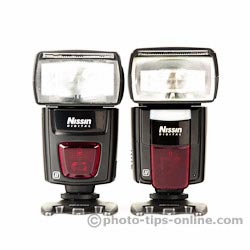 |
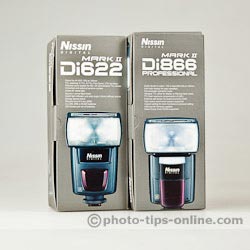 |
Nissin Di866 Mark II has a Guide Number of 60 (at 105mm, ISO 100), whereas Nissin Di622 Mark II is rated at 44. It means that the bigger flash offers almost twice as much light output (about 1 f-stop) compared to the smaller one. This kind of power difference between mid- and high-end flashes is quite typical for other brands, as well (like, Canon or Nikon, for example). Depending on your photo applications, power can be one of the most critical factors.
In some situations, it can be important how low in terms of light output you can go with your flash. Di866 Mark II is superior in this regard since it can fire at levels from full to 1/128th, whereas Di622 Mark II can only go down to 1/32th of its full power. Also note, that the power can be changed in 1/3 of f-stop increments on Di866 II, and Di622 II changes the power in 1/2-stop increments.
Both units are well-built. The quality of materials and construction is very good. The Nissin flashes may not be as rock solid as the Canon ones, but they certainly appear to be dependable.
Typically, mid-range flashes are more portable than the high-end units. In some situations, photographers are willing to trade power for portability. In case of Nissin, however, Di622 II is almost as large as Di866 II. The flash head is a bit shorter, but other than that, the flashes are pretty close in dimensions. Di622 Mark II, however, is about 20% lighter.
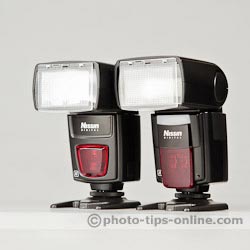 |
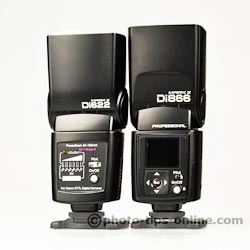 |
 |
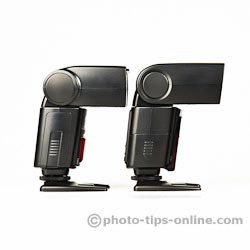 |
The sub-flash (also know as secondary reflector or wink light) is a secondary flash tube built into the body of Di866 Mark II. It can fire at the same time the main flash fires to be used, for example, as a fill light when the main flash is tilted for bouncing off of walls or a ceiling. (For examples of how a sub-flash can be used, please refer to our Metz Mecablitz 58 AF-1 wink light test). Needless to say, Di622 Mark II does not have a sub-flash.
Both flashes feature built-in catchlight cards and wide-angle panels. The flash heads turn from 90 degrees to the left to 180 degrees to the right. Both flashes can zoom from 24mm to 105mm, but with the wide-angle panel, Di622 Mark II covers the angle of 18mm lens, whereas Di866 Mark II goes as wide as 16mm.
Please note that Di622 II does not have a manual zoom mode. This can be limiting in some situations, especially when using the flash with certain light modifiers. Di866 II offers you full control over its zoom supporting both manual and automatic zooming.
It is also worth noting that the head of Nissin Di622 Mark II does not lock in the vertical position strongly enough to work with heavy flash light modifiers, like Gary Fong Lightsphere or Rogue Large FlashBender. Di866 Mark II is quite usable in this regard.
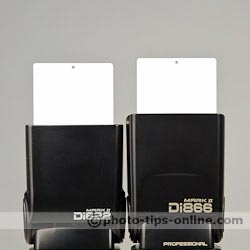 |
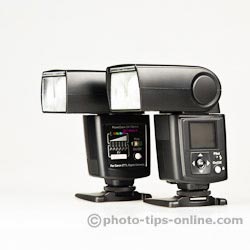 |
All portable flashes we've seen make some mechanical noise when changing zoom. Nissin Di622 Mark II is particular loud compared to the competition, but Nissin Di866 Mark II has an improved zoom motor and, therefore, is noticeably less noisy.
Both Nissin flashes make a "whining" noise when recharging after a pop. This is something many photographers are used to. Once the charging is done (after a few seconds), the smaller Di622 Mark II goes almost silent, whereas the higher-end Di866 Mark II starts producing a distinct crackling noise. This sort of noise seemed rather unusual and even concerning to us, so we contacted the Nissin's support. Fortunately, it was nothing to worry about: "...this sound is from the charging circuit, current pass through the main coil, to maintain the consistent voltage..." The noise itself is not very loud, and we got used to it pretty quickly.
Nissin Di622 II and Di866 II are very different when it comes to the interface and controls. Di622 Mark II is designed for maximum simplicity. It does not even have an LCD screen and "gets away" with just a few LED's. A four color LED reflects the current mode (TTL, Manual, Optical Slave Digital, Optical Slave Film, or Wireless), while the other 6 LED's serve as flash exposure compensation indicators.
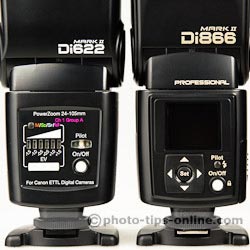 |
Nissin Di866 II, on the other hand, features color LCD, which is the first one we've seen on a portable flash. The color makes the menus even more intuitive, and the navigation is quite easy with the D-pad and set button. The menus even rotate when you turn your camera/flash from landscape to portrait orientation, which can be useful and is kind of cool.
The following two images show both Nissin flashes set to the similar setting in Manual (left) and TTL (right) modes.
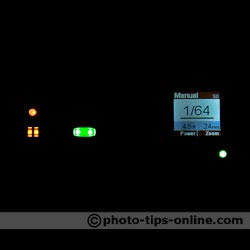 |
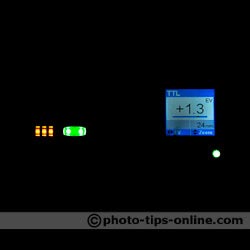 |
Please note that exposure compensation on Di622 Mark II can be set to +/-1.5 f-stop using the EV button on the flash. Additional 1.5 f-stop compensation in both direction can be achieved by using the in-camera menus.
The simplicity of Di622 II also comes at a cost of losing wireless mode settings. When set as a wireless remote flash, Nissin Di622 II always belongs to Group A and is set to Channel 1. This is definitely a limitation for photographers working with fairly sophisticated multi-flash setups, but for a significant number of hobbyists this should be acceptable.
Nissin Di866 Mark II offers a full spectrum of wireless features. It supports all channels and groups, but even more importantly, it can be used as a Master flash unit and not just a slave (remote) one.
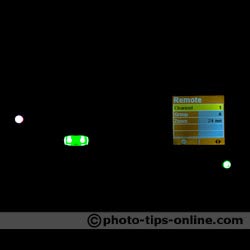 |
Both, Nissin Di622 II and Di866 II, have a PC-sync port for external triggering. In addition to that, Di622 II can be triggered via the mini-phone port, which is not available on the higher-end model. Di866 Mark II, however, offers external power pack connection for faster recycling times, and it also has a mini-USB port that makes the flash future-proof since firmware updates (once available) can be applied by simply connecting the flash to a computer.
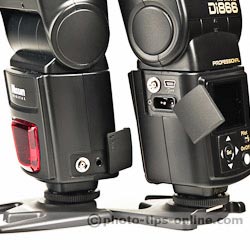 |
Nissin took very different approaches when designing battery management for these two flashes. Di622 Mark II features a conventional slide-and-pull battery compartment door. It is very similar to the one found on Canon Speedlite 580EX Mark I. Nissin Di866 Mark II accepts battery cartridges instead of the batteries themselves. Having spare cartridges with the batteries already installed allows you replacing the batteries very quickly. If such a thing is critical for your workflow, Di866 II has the edge over its little brother.
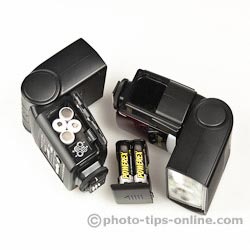 |
There is a number of features that are present on Nissin Di866 Mark II but missing on Nissin Di622 Mark II:
It is also worth mentioning that Di866 Mark II has a better AF-assist light which is rated at up to 33 feet (10 meters), whereas Di622 Mark II only reaches 20 foot mark (6 meters).
The metal foot base of Nissin Di866 Mark II is designed for better durability, and its padded case delivers better protection than the carrying bag of Di622 II.
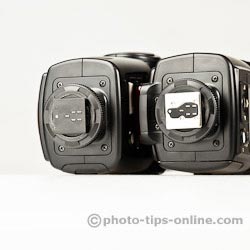 |
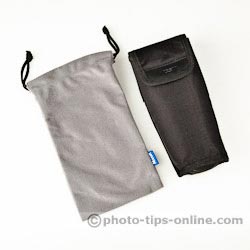 |
Nissin Di866 Mark II is more powerful and more feature reach flash unit than Nissin Di622 Mark II. Besides almost a full f-stop of power, it offers more control over the flash with its intuitive menu system and color LCD display. Things like high-speed sync and full wireless compatibility can be among must-have features on the lists on many photographers. Sub-flash and external battery pack connection should not be overlooked, as well. If you looking, however, for an extremely easy to use and more affordable flash, which still offers a good set of features, Nissin Di622 Mark II can be a good option.